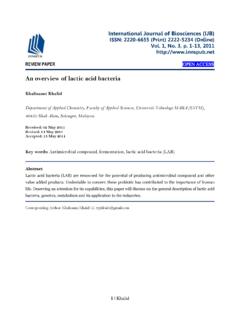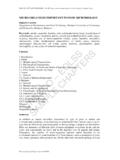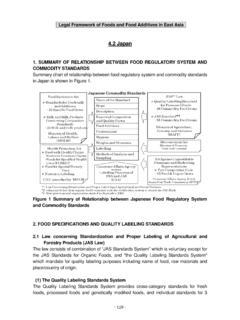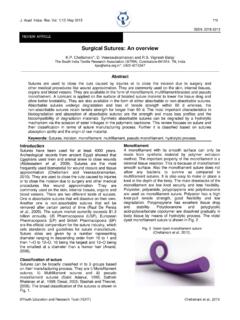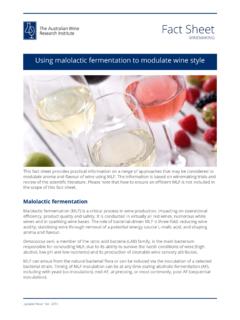Transcription of German Brewing Techniques - CraftBeer.com
1 German Brewing TechniquesAmerican Homebrewers of Today sPresentation Topics overview of the Reinheitsgebot overview of common Brewing methods Examples of some commercial beer recipes Information Sources Text Books Kunze, Narziss, Interviews with German brewers Tours of German Breweries6/21/2008 German Brewing Techniques2 Germans Brewersvs American BrewersGermanAmericanTraditionInnovation BalanceExtreme FlavorsFreshnessVarietyScienceArt6/21/20 083 German Brewing TechniquesReinheitsgebot or Purity Law Written in 1516 (oldest food law still inforce) 1516 Law is not the same as provisionsdefining Purity Law in Biersteuergesetz( beer tax law ) 1516 Law does not include the modernrequirements for labeling a beer as brewed according to the Reinheitsgebot Modern innovations have required ongoinginterpretation about what is permissible6/21/20084 German Brewing TechniquesGerman Reinheitsgebotapplies to All beer brewed in Germany and sold inGermany All beer brewed in Bavaria and BadenW rttemberg and sold in or outsideGermany6/21/20085 German Brewing TechniquesExceptions to Reinheitsgebot Beers brewed outside Germany andimported (EU ruled in 1987 law was restraint of tradebetween EU members) Beer brewed in Germany and exported(except Bavaria and Baden W rttemberg)
2 Malt beverages not labeled as beer Beer cocktails mixed in taverns Examples:Berliner Weisse, Russ n, Radler Experimental beer Homebrew6/21/20086 German Brewing TechniquesJust Don t Call it Beer!6/21/2008 German Brewing Techniques7 Radler is a mixed beerdrink of 50% Helles Bier and50% Sprite/7UP. The Britscall this a Shandy . It isusually mixed at the bar;however, Warsteiner isselling this concoction in abeer bottle, but the bottle islabeled Mischbiergetraenk and not Beer . Therefore,the Reinheitsgebot does Malt only, no adjuncts (loophole: Spitzmalz) Lager beer can only use barley malt Ales may use any malted grain (wheat, rye, spelt) Malt must be milled on site ( , no malt extract) No coloring (loophole: Farbebier, aka colored beer )6/21/20088 German Brewing TechniquesWater TreatmentKloster Brauerei Ettal, Ettal6/21/20089 German Brewing TechniquesWater Normal public water treatment allowed by Trinkwasserverordnung : chlorine, ozone, UV Treatments allowed: filtration, reverse osmosis,ion exchange, slaked lime Salts permitted.
3 Gypsum and CaCl, if added towater only Cleaning and disinfectantsolutions allowed with assumption that they are rinsed6/21/200810 German Brewing TechniquesAcidification Prohibited Addition of industrially/non-biologically produced acid Permitted Acid rest mash in at 45 C and let mash stand overnight no longercommercially practiced (too slow, too variable) Sauermalz Regular pilsner malt sprayed with Sauergut Sauergut, aka, sour wort Wort is inoculated with cultured lactic bacteria or from wortthat has been subjected to an acid rest 6/21/200811 German Brewing TechniquesSour Wortvia lactic bacteria (Sauergut)Wochinger Braeu, Woching6/21/2008 German Brewing Techniques12 Hops Pellets allowed Extracts allowed if derived by naturalsolvents like ethanol, CO2 Isomerized extracts not allowed Hops allowed in kettle only ( , no dryhopping)6/21/200813 German Brewing TechniquesYeast No nutrients or additives Oops!
4 Is that a zinc pipe Macerated and heat deactivated yeast No acid washing Lager yeast in wheat beer bottleconditioning permitted (barley kr usencan t exceed 15%/v) Brewers not as focused on strain of yeast Strain 34/70 = WY2206 & WLP8306/21/200814 German Brewing TechniquesYeast Transfer TubBrauerei Greifenklau, Bamberg6/21/200815 German Brewing TechniquesMashing Regimes Single temperature infusion Almost unheard of in Germany For a Braumeister, much too simple to make goodbeer Decoction losing popularity due to time &$ dark beers caramel & phenols (fuller, rounder flavor) wheat beers denature proteins to improve viscosity small traditional breweries Increase fermentability Step infusion mash most common Endosperm mashing Trumer6/21/200816 German Brewing TechniquesGerman Mashing RegimesRequire SophisticatedEquipment Mash agitator Mixing during step infusion Mixing for decoction Lauter tun rakes Decoction and pumping dearates mash so it won t float as inBritish-style single temperature infusion Mash pump6/21/200817 German Brewing TechniquesMash Tunnote the 2 agitator arms and copper chain to preventscorching6/21/200818 German Brewing TechniquesClassic Mash TemperaturesTempPurpose35 C(optional)
5 Starting point for mash in, especially triple decoction45 C(optional) degrade -glucans & produce ferulic acid _ 4 VG inWeissbier50 Cprotein rest & degrade -glucans62 Cgelatinization/liquefaction (beta amylase)72 Csaccharification (alpha amylase)78 Cmash off6/21/200819 German Brewing TechniquesWater:Grist Ratios (wt/wt, 1liter = 1kg, 1qt 2 lb) Mash more liquid than English infusionmashes because German mashes are stirredand pumped Water grist ratios are adjusted for beer type to : 1 dark and/or malty beers (Maerzen) to 5 : 1pale and delicate beers (Pils) Lower water : grist ratio requires moresparging: _efficiency _ _ phenols _ _ fermentability Higher water: grist ratio requires lesssparging.
6 _ efficiency _ _ phenols _ _ fermentability6/21/200820 German Brewing TechniquesLautering Continuous sparging is probably morecommon in larger breweries Batch sparging with 2 or 3 sparge wateradditions ( Nachg sse ) Less common to heat kettle intensely whilefilling convert starch to dextrins @ 75 C, start heating at kettle full Consistent flavor and stability from consistent boilingparameters, time and temperature6/21/200821 German Brewing TechniquesLauter TunBrauerei Greifenklau, Bamberg6/21/200822 German Brewing TechniquesHops 1 to 4 additions depending on style Aroma hops are usually boiled 5 to 10minutes to remove grassy flavors No dry hopping, but hops are sometimesadded right before whirlpool.
7 But not inwhirlpool No bittering or hop oil extract can beadded after kettle6/21/200823 German Brewing TechniquesKnockout Aerate in-line between chiller andfermenter with sterile air (not oxygen) Knockout colder than fermentation temp. Flotation tanks for lagers when fermentedin flat bottom fermenters Can t remove trub in flat bottom fermenter Can t harvest yeast if flat bottom filled with trub6/21/200824 German Brewing TechniquesCoolship at Bavarian FarmBrewery6/21/2008 German Brewing Techniques25 Top Fermentation (ales) Open fermenters still common for Weissbier,brewpubs, and traditional Bavarian lagerbreweries Skim and remove trub first +/- 2 days Then harvest yeast by skimming Pitching rates Weizen - 5 to 10MM cells/ml Yeast cells double more times at warm temps Yeast growth promotes higher ester production Perhaps higher rate for cool fermented Altand Koelsch due to colder temp and lowerester profile6/21/200826 German Brewing TechniquesWeissbier FermenterSchneider6/21/200827 German Brewing TechniquesOpen Brewpub FermentersFliegerbraeu, Munich6/21/2008 German Brewing Techniques28 Bottom Fermentation (lager)
8 Pitch 15 to 30MM cells/ml Knockout colder than fermentation temperature @ 6 to8 C Oxygen solubility _ Protection against invading microbes Reduces fruity/spicy higher alcohols and esters Free rise to 9 to 10 C, achieve about 80 - 90% ofattenuation limit in 1 week Drop to lagering temperature (0 to 2 C) by 1 C/day(DON T CRASH!!!!!) Condition for 3 or more weeks (diacetyl rest sometimesused by larger brewers up to 20_C) Tank is bunged and remaining extract (1 2% remainingfermentable extract) or added kraeusen (10%)carbonates beer6/21/200829 German Brewing TechniquesOpen Lager Fermenter (Kloster Brauerei Ettal, Ettal)6/21/200830 German Brewing TechniquesOpen Lager Fermenter(Kloster Brauerei Ettal, Ettal)
9 6/21/200831 German Brewing TechniquesOpen Lager TankBrauerei Greifenklau, Bamberg6/21/200832 German Brewing TechniquesClarification/Filtration Not Permitted these are not inert, can t be fully removed Irish moss Isinglass Forced carbonation from CO2, if not produced byfermentation Permitted inert ingredients that can be removed by filtration orsedimentation PVPP (plastic flakes that adsorb tannin) Silica gel DE and cellulose filters Carbonation by spunding (bunging) and kr usen Forced carbonation from CO2 captured from fermentationOK6/21/200833 German Brewing TechniquesSpundapparatpressure-relief valve for carbonation6/21/2008 German Brewing Brewers Are VeryMindful of pH thorough outentire process to pH in the mash to at end of boil to at end of fermentation ( bacteriaactive and taste affected) Focus on the beer pH, not the mash!
10 !!!!! Homebrew pH is often too high!6/21/200835 German Brewing TechniquesGerman Lagers may have higherlevels of SO2 (sulfur dioxide)than American lagers SO2 should not to be confused with: DMS inadequate boil (should never be found inGerman lager) H2SO stressed yeast / unwanted microbes Lager yeast naturally produce more SO2 thanale German Brewing Techniques produce/trap moreSO2 Cold fermentation, cold lagering Natural carbonation (forced carbonation scrubs SO2)6/21/200836 German Brewing TechniquesFactors contributing toincreased SO2Dr. Greg Casey, Coors Brewing Lager yeast strain produces more S02 thanale Spunding and kraeusen (trapped CO2) Sulfates in water Cold temperature (Miller beer fermented at 10 C 2xmore SO2 than at 15 C)

